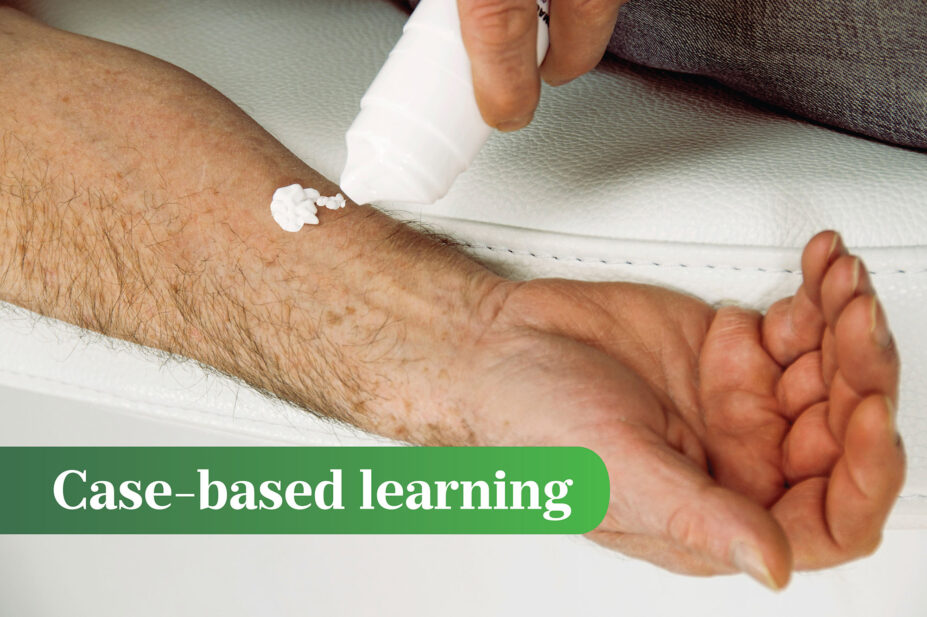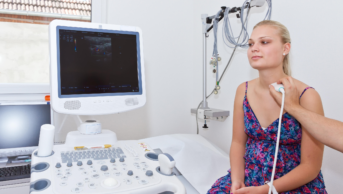
LEA PATERSON/SCIENCE PHOTO LIBRARY
Testosterone deficiency (TD) syndrome in men, otherwise known as male hypogonadism, is a common endocrine disorder defined by the International Society for Study of the Ageing Male, European Association of Urology, International Society for Sexual Medicine and British Society of Sexual Medicine (BSSM) as “a biochemical syndrome associated with advancing age and characterised by a deficiency in serum androgen levels with or without a decreased genomic sensitivity to androgens”[1–4].
In recent years, there has been an increase in men having their testosterone levels checked in primary care, possibly because of increased public awareness of androgen deficiency. This has resulted in a marked increase in the number of men diagnosed with low testosterone levels requiring treatment in some form[5].
Framing the condition as a physical health issue, rather than a personal failing, helps to remove the stigma and psychological burden patients experience when diagnosed with TD[6]. Through raising awareness of TD, the diagnosis becomes ‘normalised’, ultimately meaning more men obtain the help they may require.
Community pharmacists are some of the most readily accessible healthcare professionals in the UK, with data published in 2022 showing that 89% of the population in England have access to a community pharmacy within a 20-minute walk[7]. As a result, community pharmacists are uniquely situated to support diagnosis and identification of TD.
Community pharmacists are also highly likely to have frequent interaction with patients who have chronic health conditions that are commonly comorbid with TD, such as atherosclerotic cardiovascular disease (ASCVD), type 2 diabetes mellitus (T2DM) or obesity[2,8–10]. This exposure presents pharmacy professionals with the opportunity to identify patients at higher risk of TD and initiate discussions about their general health to ascertain if they are experiencing any generalised signs and symptoms patients may have overlooked. They can then be appropriately counselled and signposted to diagnostic services for investigation where indicated.
Pharmacists working in other sectors may be more involved in the direct management of these patients. For example, pharmacists working in primary care may encounter these patients more through involvement in chronic disease management clinics with dedicated consultation time to address health concerns. Similarly, those in secondary care or specialist teams may provide support to dedicated endocrine clinics or outpatient units to assist ongoing prescribing and monitoring response for patients on established treatment.
This article will cover the symptoms pharmacists should be aware of, the diagnosis of TD, considerations for pharmacological management and any additional advice that can be provided to patients.
Additional information on the pathophysiology and aetiology of TD can be found in ‘Testosterone deficiency: diagnosis, assessment and treatment’.
Causes and risk factors
TD can affect men of any age, but incidence increases with advancing age, with a 1% drop per year in testosterone levels starting from 30 years of age. There is also an association with other comorbidities, which is evidenced in literature that shows over a third of males with T2DM have low testosterone and the risk of TD is nearly nine times more likely to occur in obese males[2,8–12].
Aetiology and classification
TD encompasses a variety of conditions that cause or result in androgen deficiency. They can be classified according to aetiology and origin of the dysfunction, which can be either primary owing to failure of testicular function affecting androgen production (e.g. Klinefelter syndrome) or secondary, also known as central, which arises from hormonal imbalance within the hypothalamic-pituitary-gonadal axis (e.g. owing to medication or damage to the pituitary gland directly)[4]. This distinction between primary or secondary causes is clinically relevant with subsequent therapeutic interventions and further testing dependant on type[13].
Additional categorisation may be assigned if the cause is congenital or acquired later in life or if the cause is organic or functional[14]. A summary is listed in Table 1.
Symptoms
Signs and symptoms of TD are varied and often non-specific in nature, such as fatigue or low mood, which can complicate the diagnosis and assessment[13]. The most clinically indicative signs and symptoms of TD are summarised in Table 2.
Patients and healthcare professionals often more readily associate these symptoms with the comorbidities commonly seen in men with TD on presentation; such as fatigue or low mood[9]. This can delay correct diagnosis and subsequent progression to treatment, which can only be avoided by remaining mindful of the potential for TD in these cohorts. TD can significantly impact patients’ quality of life, adversely affecting several organ systems functions and, therefore, presentation can vary between cases[1–4].
Diagnosis
In 2019, Satchi and Muneer provided a detailed and robust summary of the history-taking consultation points, physical examination and biochemical investigations that pharmacy professionals should be aware of for the diagnosis of TD[15].
To summarise, two main characteristics are required for diagnosis;
- Presence of sexual, psychological or physical TD symptoms;
- Clear and consistent low serum total testosterone levels (or free testosterone concentration in those with conditions that alter sex hormone binding globulin SHBG)[13].
Further information on history taking, physical examinations and investigations can be found in ‘Testosterone deficiency: diagnosis, assessment and treatment’.
Treatment
While the aims of TD treatment are specific to the aetiology and cause of the deficiency, treatment is generally aimed to ensure an individual’s complete and sustained sexual development, correct any symptoms associated with the deficiency and reduce the risk of health consequences related to continual deficiency, such as osteoporosis[13].
Choice of treatment depends on the aetiology of the individual’s TD, as well as other patient factors, such as age, desire for fertility and comorbidities[8].
In patients whose TD arises outside of the hypothalamic-pituitary-gonadal axis, the most common intervention is to treat the underlying cause, such as lifestyle interventions for obesity management[16]. If symptoms cannot be reversed through initial intervention alone, testosterone replacement therapy (TRT) can be considered.
Men with primary hypogonadism who are not seeking fertility are usually treated with TRT[13,16]. There is a wide range of formulations available but, in practice, topical gels or intramuscular forms are most commonly prescribed. Patients with forms of secondary hypogonadism, such as those with combined pituitary hormone deficiencies or congenital hypogonadotropic hypogonadism, should also be offered TRT.
Patients with prolactinoma — a non-cancerous tumour of the pituitary gland — should initially be treated with dopamine agonist monotherapy, such as cabergoline or bromocriptine, but may be offered TRT as second-line therapy[16].
Additional information on TRT, including commencing TRT, formulation duration and contraindications can be found in ‘Testosterone deficiency: diagnosis, assessment and treatment’.
Men who seek fertility should be offered assisted reproductive therapy instead of TRT, principally consisting of hormone therapies or IVF with their female partner[16]. While men with secondary hypogonadism who seek fertility are treated with human chorionic gonadotrophin hormone (hCG) alone or alongside follicle stimulating hormone (FSH) to stimulate sperm and endogenous testosterone production[16].
Those with active or suspected breast cancer or prostate cancer should not be offered TRT owing to associated risk of tumour growth[13].
Case studies
The following cases discuss common scenarios that pharmacy professionals may encounter in community, primary or secondary care. The cases vary in complexity relative to the scenario in which they are encountered, but there are important themes of strong professional skills through adept counselling and decision making in conjunction with knowledge of the condition highlighted throughout.
Case 1
A 51-year-old male attends the GP practice for his annual review in your pharmacist-led T2DM clinic. He has been seen in the clinic previously and seems well informed regarding management of his glycaemic control and cardiovascular risk, but he has struggled to lose weight despite sufficient lifestyle adjustments. His results today show a HbA1c of 52mmol/mol, blood pressure of 138/74mmHg, total cholesterol of 3.8mg/dL and a BMI of 31.
Towards the end of the consultation, he discloses he is experiencing intimacy issues with his partner. He has read that diabetes can potentially cause sexual dysfunction so wondered if this could be the cause of their issues. He is able to provide more detailed context of their experience, describing feeling like he has lost his libido, as well as some erectile dysfunction.
There are a number of questionnaires such as the ‘Androgen Deficiency in Ageing Males’ or the ‘Ageing Males Symptoms Scale’ available, which can be used to provide context to the patient’s history and guide investigations[17,18]. Although the latter is endorsed by the BSSM guidance, the Society for Endocrinology advises against using these in practice owing to limited real-world data on their use[13].
While this patient is not an older person, he has other risk factors including obesity and T2DM. These, alongside sexual, psychological or physical symptoms suggestive of TD, indicate he would require measurement of his total testosterone levels to rule out deficiency. He should be counselled, as this may require referral to a local endocrine clinic for assessment. Box 1 below includes some suggested approaches pharmacy professionals could take in this instance.
Box 1: Suggested consultation prompts for testosterone deficiency investigations
“The symptoms you’ve mentioned today may indicate an element of low testosterone. It’s nothing to be immediately concerned about but we could check your levels today and book you back in to see the GP to discuss the results if you like?”
Or:
“Erectile dysfunction can happen to patients owing to their diabetes. This would be a type of nerve damage called neuropathy that has impaired the nerves that cause erection following stimulation. As your blood glucose has always been reasonably controlled, it’s possible something else is going on. Considering your BMI of 31, diabetes and age, this might owe to low testosterone levels. Have you heard of testosterone deficiency previously?”
This patient consented to testosterone testing and was referred to the specialist endocrine clinic. His total testosterone was 8.1nmol/L (total testosterone of less than 10.4nmol/L is indicative of TD). Following a repeat level to confirm, he was commenced on TRT, opting for the 12-weekly injection through the outpatient injection clinic[16]. Prior to his injections, a hospital pharmacist would review his annual monitoring bloods, including his total testosterone, haematocrit and prostate-specific-antigen (PSA) before supplying for administration.
Should he struggle to see an improvement on testosterone, the patient and prescribing professional should discuss the risks and benefits of remaining on treatment and, while guidance recommends TRT is not trialled in a time-dependant manner but used life-long, this must be weighed against the potential risks of therapy, including an increased risk of prostate cancer, myocardial infarction or venous thromboembolism[19].
Case 2
A 35-year-old male patient attends your secondary care pharmacist-led growth hormone clinic for his annual growth hormone review. He was originally diagnosed with a non-functioning pituitary adenoma eight years ago and underwent transsphenoidal pituitary resection. He now suffers from partial hypopituitarism and is treated with 0.3mg daily of somatropin and is on cortisol replacement with hydrocortisone (10mg in the morning, and 5mg at lunch and in the evening).
Owing to the COVID-19 pandemic and a missed appointment, it has been 22 months since he was last seen. After conducting a physical examination of his visual fields and ruling out signs of adenoma recurrence, such as headache or vomiting, he mentions that he and his partner have been trying for a baby for some time and are struggling to conceive. Further questioning reveals there is some potential fatigue but no other concerning symptoms.
Society for Endocrinology guidelines recommend measuring serum testosterone, FSH and LH to assess gonadotropins[13]. This patient would next need to be seen by a consultant endocrinologist who could perform a more thorough examination in conjunction with test results to assess fertility, such as testes size and semen analysis.
This patient was found to have a hypogonadotropic hypogonadism — a form of secondary TD — with low total testosterone, low FSH and reduced sperm count. Owing to his wish to reproduce in the near future, his treatment options were limited, because the initiation of TRT would initially suppress LH and FSH and reduce spermatogenesis, therefore he commenced hCG 250units three times a week[16]. He and his partner successfully conceived seven months later, following which he ceased hCG treatment moved to TRT to prevent anaemias, improve bone density and reduce fat mass while supporting muscle mass[20].
Case 3
A 67-year-old man presents to your community pharmacy. He has been looking online and believes he may be suffering TD because he is very fatigued and understands from the internet that it is common in older men. He is keen to try some testosterone supplements and wants to know if he can purchase these. A suggested response is outlined in Box 2 below.
Box 2: Suggested response to request for testosterone supplements
“You’re quite right. Testosterone levels do naturally start to dip as men age but that doesn’t always mean there’s a problem that needs treating because this is a natural part of ageing. Fatigue is one of those symptoms that can owe to a whole host of conditions, so it would certainly be worth booking an appointment with your GP to discuss why this might be happening to you.
“As for the testosterone, it is a medicine called an androgen. Like all medicines, there are risks and benefits of taking it so it is not available to purchase over the counter and it would need to be prescribed by your GP or the specialist team at the hospital.
“Often, as testosterone levels decline naturally, testosterone is not routinely prescribed for older men unless they’re experiencing a condition as a result of low testosterone, such as osteoporosis, or if they’re actively suffering more specific symptoms resulting from the deficiency.
“I can print you some more specific information on this if you would like to read before you book in with the GP?”
Society for Endocrinology guidance on testosterone replacement advises against the prescribing of TRT for asymptomatic males aged over 65 years[13]. TRT would only be indicated in the presence of suggestive conditions, such as unexplained anaemia, alongside low testosterone levels as non-specific symptoms are often present in older patients without a true causal link[13].
The patient proceeds to booking a GP appointment to discuss his concerns. The GP explains testosterone therapy in more detail, outlining the risks as well as the benefits of treatment in men with low serum levels. The patient decides his symptoms are not severe enough to outweigh these considerable risks, and the GP and the patient together agree there is no benefit of checking testosterone levels as it will not change patient’s symptom management.
Conclusion
TD is a common endocrine disorder than can vary in aetiology from simple to complex. Pharmacy professionals in any sector are likely to encounter patients with TD owing to their need for replacement therapy as well as other associated long-term conditions.
- 1Lunenfeld B, Mskhalaya G, Zitzmann M, et al. Recommendations on the diagnosis, treatment and monitoring of hypogonadism in men. The Aging Male. 2015;18:5–15. https://doi.org/10.3109/13685538.2015.1004049
- 2Dohle G, Arver S, Bettocchi C, et al. EAU Guidelines on male hypogonadism. European Association of Urology. 2019. http://uroweb.org/guideline/male-hypogonadism/ (accessed December 2023)
- 3Dean JD, McMahon CG, Guay AT, et al. The International Society for Sexual Medicine’s Process of Care for the Assessment and Management of Testosterone Deficiency in Adult Men. The Journal of Sexual Medicine. 2015;12:1660–86. https://doi.org/10.1111/jsm.12952
- 4Hackett G, Kirby M, Wylie K, et al. British Society for Sexual Medicine Guidelines on the Management of Erectile Dysfunction in Men—2017. The Journal of Sexual Medicine. 2018;15:430–57. https://doi.org/10.1016/j.jsxm.2018.01.023
- 5Al-Sharefi A, Wilkes S, Jayasena CN, et al. How to manage low testosterone level in men: a guide for primary care. Br J Gen Pract. 2020;70:364–5. https://doi.org/10.3399/bjgp20x710729
- 6Berg L, Linander I. Hypogonadism. Diagnosis, masculinity, and capital in narratives about testosterone deficiency. NORMA. 2022;18:5–20. https://doi.org/10.1080/18902138.2022.2121534
- 7About community pharmacy — the accessibility of community pharmacies. Community Pharmacy England. 2022. https://cpe.org.uk/learn-more-about-community-pharmacy/about-community-pharmacy (accessed December 2023)
- 8Bhasin S, Brito JP, Cunningham GR, et al. Testosterone Therapy in Men With Hypogonadism: An Endocrine Society* Clinical Practice Guideline. The Journal of Clinical Endocrinology & Metabolism. 2018;103:1715–44. https://doi.org/10.1210/jc.2018-00229
- 9Corona G, Monami M, Rastrelli G, et al. Type 2 diabetes mellitus and testosterone: a meta-analysis study. International Journal of Andrology. 2010;34:528–40. https://doi.org/10.1111/j.1365-2605.2010.01117.x
- 10Ruige JB, Mahmoud AM, De Bacquer D, et al. Endogenous testosterone and cardiovascular disease in healthy men: a meta-analysis. Heart. 2010;97:870–5. https://doi.org/10.1136/hrt.2010.210757
- 11Tajar A, Forti G, O’Neill TW, et al. Characteristics of Secondary, Primary, and Compensated Hypogonadism in Aging Men: Evidence from the European Male Ageing Study. The Journal of Clinical Endocrinology & Metabolism. 2010;95:1810–8. https://doi.org/10.1210/jc.2009-1796
- 12Al Hayek A, Khader Y, Jafal S, et al. Prevalence of low testosterone levels in men with type 2 diabetes mellitus: a cross-sectional study. J Fam Community Med. 2013;20:179. https://doi.org/10.4103/2230-8229.122006
- 13Jayasena CN, Anderson RA, Llahana S, et al. Society for Endocrinology guidelines for testosterone replacement therapy in male hypogonadism. Clinical Endocrinology. 2021;96:200–19. https://doi.org/10.1111/cen.14633
- 14Nieschlag E, Behre HM, Nieschlag S, editors. Andrology. Springer Berlin Heidelberg 2010. https://doi.org/10.1007/978-3-540-78355-8
- 15Testosterone deficiency: diagnosis, assessment and treatment. Pharmaceutical Journal. 2019. https://doi.org/10.1211/pj.2019.20206364
- 16Quinton R, Jayasena C. Hypogonadism in men. BMJ Best Practice. 2023. https://bestpractice.bmj.com/topics/en-gb/1093 (accessed December 2023)
- 17Mohamed O, Freundlich RE, Dakik HK, et al. The quantitative ADAM questionnaire: a new tool in quantifying the severity of hypogonadism. Int J Impot Res. 2009;22:20–4. https://doi.org/10.1038/ijir.2009.35
- 18Moore C, Huebler D, Zimmermann T, et al. The Aging Males’ Symptoms Scale (AMS) as Outcome Measure for Treatment of Androgen Deficiency. European Urology. 2004;46:80–7. https://doi.org/10.1016/j.eururo.2004.01.009
- 19Vigen R. Association of Testosterone Therapy With Mortality, Myocardial Infarction, and Stroke in Men With Low Testosterone Levels. JAMA. 2013;310:1829. https://doi.org/10.1001/jama.2013.280386
- 20Fleseriu M, Hashim IA, Karavitaki N, et al. Hormonal Replacement in Hypopituitarism in Adults: An Endocrine Society Clinical Practice Guideline. The Journal of Clinical Endocrinology & Metabolism. 2016;101:3888–921. https://doi.org/10.1210/jc.2016-2118


